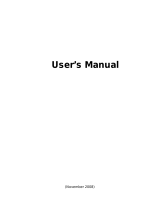
xiv User’s Manual
ENERGY STAR
®
Program
Your computer model may be Energy Star
®
Compliant. If
the model you purchased is compliant, it is labeled with
the ENERGY STAR logo on the computer and the
following information applies. TOSHIBA. is a partner in the
Environmental Protection Agency’s (EPA) Energy Star
Program and has designed this computer to meet the
latest Energy Star guidelines for energy efficiency. Your
computer ships with the power management options preset to a
configuration that will provide the most stable operating environment and
optimum system performance for both AC power and battery modes.
To conserve energy, your computer is set to enter the low-power Sleep
Mode which shuts down the system and display within 15 minutes of
inactivity in AC power mode. We recommend that you leave this and other
energy saving features active, so that your computer will operate at its
maximum energy efficiency. You can wake the computer from Sleep Mode
by pressing the power button.
According to the EPA, a computer meeting the new ENERGY STAR
specifications will use between 20% and 50% less energy depending on
how it is used. If all U.S. household and businesses replaced old
computers with new ENERGY STAR qualified models, we would save more
than $1.8 billion in energy costs over the next five years and avoid
greenhouse gas emissions equivalent to more than 2.7 million cars.If every
computer purchased by businesses next year met the new ENERGY STAR
requirements, businesses would save more than $210 million over the
lifetime of those models. That is equivalent to lighting 120 million square
feet of U.S. commercial building space each year.
Visit http://www.energystar.gov or http://www.energystar.gov/
powermanagement for more information regarding the ENERGY STAR
Program.
Disposing of the computer and the computer’s batteries
■ Discard this computer in accordance with applicable laws and
regulations. For further information, contact your local government.
■ This computer contains rechargeable batteries. After repeated use, the
batteries will finally lose their ability to hold a charge and you will need
to replace them. Under certain applicable laws and regulation, it may be
illegal to dispose of old batteries by placing them in the trash.
■ Please be kind to our shared environment. Check with your local
government authority for details regarding where to recycle old batteries
or how to dispose of them properly. This product contains mercury.
Disposal of this material may be regulated due to environmental
considerations. For disposal, reuse or recycling information, please
contact your local government.






















